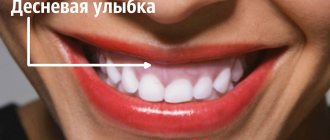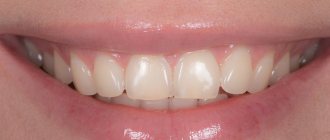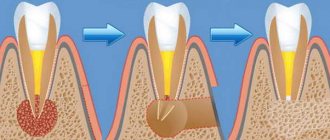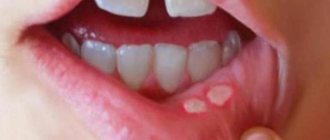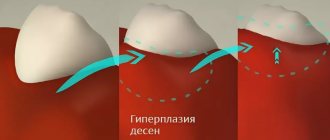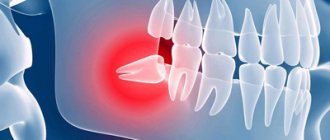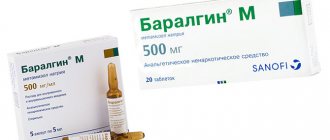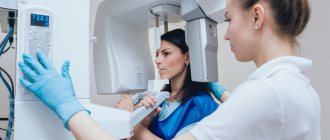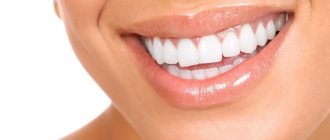A gummy smile is a serious aesthetic defect. When a person smiles, the upper gum is visible to others - it looks ugly. Not everyone succeeds in “relearning” so that their smile becomes more closed, so many people are forced to put up with this shortcoming all their lives. Fortunately, there are modern cosmetic correction methods. Sign up for a gummy smile treatment at the BL clinic - and you will smile more often!
Causes of gummy smiles in children and adults
In adults, a gummy smile is quite rare, since this problem in most cases appears in childhood. There are several known main reasons for the appearance of this problem: improper development of the facial skeleton, a short upper lip that cannot cover the gum, or, on the contrary, an overly large gum that covers the upper row of teeth more than necessary. At the same time, a strongly pronounced gummy smile, as a rule, is a consequence of malocclusion, or anomalies in the development of the maxillofacial skeleton.
Features of the procedure and recovery
Gingivoplasty is performed with local anesthesia
. Depending on the complexity and scope of the tasks, the procedure takes from half an hour to several hours - it includes anesthesia, disinfection, direct work on the periodontium, cleaning of dental/bacterial plaque (if necessary), suturing, etc.
Healing time
also depend on the specifics of the intervention - usually from one to several weeks. The swelling subsides within 2-7 days. While the gums are being restored, the teeth may become a little loose, and increased sensitivity may also occur, but these phenomena will pass as the tissue heals. In general, during the rehabilitation period, patients should adhere to the following recommendations:
- carefully monitor oral hygiene (rinse your mouth after eating, use special solutions), but do not brush or paste the area where the operation was performed;
- Avoid foods that may irritate tissue. Excessively hard, hot, cold, spicy, sour foods, etc. are excluded;
- avoid physical activity, excessive shaking and anything that prolongs the healing period;
- use disinfecting solutions according to the schedule prescribed by the doctor;
- wear a special mouthguard.
Your doctor will give you detailed recommendations specific to your case.
Reconstructive surgery in the treatment of gummy smiles
In situations where a gummy smile appears as a result of abnormal development of the facial skeleton, the only effective solution to the problem is surgery. For these purposes, osteotomy (correction of the upper jaw) and ostectomy (operation performed to correct the lower jaw) are used.
In the vast majority of cases, such surgical interventions are carried out in the presence of serious anomalies in the development of the bite, but can also be performed in the normal position of the jaws, for example, to correct a gummy smile.
Tissue removal – treatment of gum pockets
Tissue removal is usually associated with gum pockets that are too large
– another consequence of
periodontitis
. The normal pocket size is up to 3 mm. As the disease progresses, the pockets enlarge, food debris gets stuck in them, bacteria multiply, which leads to new inflammation and further enlargement of the pockets. If they become very voluminous, they are no longer able to shrink to a normal state, and in such cases, surgical intervention is considered the optimal treatment option.
Patchwork technology can also be used here
. First, the doctor removes damaged and “extra” tissue, and then forms flaps of the correct shape. As a rule, the specialist’s task includes thorough cleaning of the problem area and the base of the tooth from bacterial plaque, tartar, etc. The procedure ends with suturing.
What determines the cost of the operation?
The cost of gingivoplasty depends on the chosen method and the extent of surgical intervention.
Any, even the most advanced situation on the gums can be corrected and made better and more beautiful. But in some situations, previously performed procedures complicate the process of rehabilitation with old scars.
All types of gingival margin reconstruction directly depend on the gum biotype. The thicker the gingival contour, the cheaper and simpler the treatment. If the gums are of the ultra-thin biotype, any surgical treatment will be a challenge for the patient and the doctor.
Dimple on the chin
A dimple on the chin is formed as a result of contraction of the mentalis muscle. The BTA drug is injected into one or two symmetrical points located approximately 1 cm from the line dividing the face in half directly above the protrusion of the chin. It is not allowed to insert BTA closer than 1 cm from the lower lip. Since the mentalis muscle is located deeper than the others, intramuscular injection is recommended to the periosteum, below the dimple. This will prevent the toxin from spreading into the orbicularis oris muscle. Some authors argue that, despite the deep location of the mentalis muscle, good results can be achieved with superficial injections (Figure 15)
. The recommended total dose is 2.5-8 units. Botox® or 2.5-20 units. Dysport®.
Figure 15. BTA insertion points for correction of dimpled chin
Complications: As long as the restrictions on BTA insertion near the lower lip are observed, this procedure does not entail any complications other than bruising and hematomas.
Indications and contraindications
A common reason for coming to Avalon for this procedure is to eliminate a gingival smile. Disproportion between teeth and gums is a problem for many people, so they don’t like to show their smile to others.
However, lengthening the crown of the tooth also has medical indications:
- pathological abrasion of enamel;
- subgingival caries;
- installation of an artificial crown.
There are very few contraindications. These include only serious diseases: oncology or complex pathologies of the structure of the oral cavity.
Prices for gum surgery
| Service | Price |
| Consultation + treatment plan | For free |
| Flap surgery in the oral cavity for 1 tooth | from 2,850 rub. |
| Flap surgery in the oral cavity for 1 tooth + graft connective tissue sampling | from 6,700 rub. |
For information about additional discounts and promotions, please call our consultants or attend a free initial appointment.
Expert of the article you are reading: Kubasova Natalya Vyacheslavovna Orthodontist, leading specialist of the NovaDent network
15 years
Clinical experience
Otradnoe
st. Khachaturyan, 7
+7 +7
Free consultation with this specialist
Wrinkles in the perioral area
With age, the lips undergo a number of changes, including shortening of the lateral part, enlargement of the dermal part of the upper lip, thinning of the red border and the appearance of many vertical wrinkles around the mouth. These wrinkles, also called smoker's lines, can be the result of sun exposure, smoking, hereditary factors and overactive orbicularis oris muscle, such as in musicians. There are several ways to eliminate wrinkles on the upper lip, including filler injections and various anti-aging procedures. Botulinum therapy is used to correct age-related changes in the perioral area, especially in the presence of deep static wrinkles.
Treatment of the orbicularis oris muscle with BTA preparations is carried out with extreme caution in order to achieve the effect of reducing wrinkles and not affect the normal functioning of the oral area. In addition, it is unacceptable to administer BTA near the corners of the lips. Otherwise, relaxation of the muscles that raise the corners of the lips under the influence of the toxin will lead to ptosis of the lips and drooling. Injecting BTA above the middle of the upper lip will lead to a smoothing of the cupid's bow, which is an undesirable effect from an aesthetic point of view.
In general, 1-2 injections are made into each quarter of the perioral area. To avoid dysfunction of the oral area, it is recommended to administer BTA preparations in very small doses. When the toxin is injected 5 mm from the border of the red part of the lips, the secondary aesthetic effect of a slight eversion of the lip is achieved (Figure 13)
.
Figure 13. BTA injection points for the correction of wrinkles in the perioral region
Complications: An overdose of BTA preparations will lead to dysfunctions of the lips such as the inability to fold them into a tube, difficulty pronouncing plosive consonants, and difficulty eating and drinking. For this reason, it is recommended to start botulinum therapy in the perioral area with minimal doses and repeat them as necessary.
Comment by cosmetologist, dermatovenereologist Ya. A. Yutskovskaya:
— When performing BTA injections in the perioral area, it should be remembered that the muscles located around the lips are involved in the implementation of important physiological functions. Therefore, correction of this zone must be carried out very carefully. The orbicularis oris muscle is divided into the marginal part (pars marginalis) and the labial part (pars labialis). Injections of BTA into the labial part allow the lips to be slightly turned out, which creates the effect of increasing their area and volume. Injections into the marginal part of the orbicularis oris muscle are performed in the presence of purse-string wrinkles. Dividing the skin portion of the lip in half and retreating at least 5 mm from the columns of the philtrum and from the corners of the mouth, subcutaneous injections are usually made at 2 points on each side in a dose of 2-5 units. Dysport.
Why is it better to do gingivoplasty “in your sleep”?
If the patient is very afraid and worried about the upcoming operation, we suggest performing it under sedation. This is an immersion into a state of light sleep with the help of safe sleeping pills under the supervision of our experienced anesthesiologist.
Sleep therapy provides:
- Maximum comfort A person does not feel pain or experience emotional stress. Awakening is, as usual, quick and easy.
- High-quality treatment The doctor is 100% focused on the operation, eliminating the possibility of inaccurate actions due to random movements of the patient.
- Risk prevention The patient is not worried, the blood pressure is normal, the risk of bleeding, and therefore the formation of edema and hematomas, is lower.
- Improved healing There is no release of stress hormone, which reduces the immunological status and slows down the regeneration processes.
Combined techniques
BTA preparations are used both separately and in conjunction with other agents, during one or more sequential procedures aimed at treating different layers of the skin and its imperfections. Over the past few years, the principles of facial rejuvenation have undergone significant changes and have moved from a two-dimensional approach to correcting hypodynamic wrinkles to a three-dimensional approach, which also includes the aspect of tissue volume lost with age. This has led to some changes in the clinical use of BTA drugs. Now doctors are trying to correct not one, but several areas at once in order to achieve the most natural result. In addition, BTA preparations are increasingly used in conjunction with other products, including dermal fillers. The combined use of BTA and fillers corresponds to the concept of a three-dimensional approach to rejuvenation and provides more aesthetically attractive and long-lasting results. When administered together with a filler, BTA slows down metabolic processes in the surrounding tissues and thereby prolongs the period of action of the filler.
BTA also enhances the effect of laser rejuvenation, since collagen production in immobilized tissues occurs faster. For example, excellent aesthetic results can be achieved using laser lip rejuvenation with preliminary (1-2 weeks before) administration of BTA. Regular (with an interval of 4-6 weeks) BTA injections after anti-aging procedures prolong their effect.
In addition, BTA preparations are successfully used in conjunction with chemical peels, especially in patients with signs of photoaging.
BTA injections can also be combined with various plastic surgeries, for example, eyebrow lifting, blepharoplasty of the lower and upper eyelids and rhytidectomy.
Types of gum surgery
The type of plastic surgery is determined by the doctor depending on the indications and condition of the gums, as well as the intended purpose.
Gum augmentation
Methods are used that restore gum volume when it is deficient.
- Vestibuloplasty An operation to deepen the vestibule of the oral cavity by increasing the volume of fixed gums that are too tightly fused with the muscles of the lips, cheeks or tongue. It is used if the tension of the facial muscles during speech communication and the process of chewing chronically injures the attached gum, which leads to its recession, the formation of periodontal pockets and exposure of tooth roots.
- Frenuloplasty The procedure of cutting the frenulum of the lips or tongue. It is used for congenital pathologies of the development of the frenulum, which provoke the appearance of a gap between the front incisors, the formation of gum pockets, excessive accumulation of dental plaque, gum disease, and exposure of tooth roots.
- Application of grafts Surgery to close gum recession by moving donor flaps from other parts of the oral cavity (gums, hard palate). In rare cases, it is possible to use special collagen membranes, which trigger the process of natural regeneration of the damaged area, but this option is not suitable for all patients.
Reducing the volume
An operation is performed - gingivectomy. This is the surgical excision of overgrown gum tissue during hypertrophy.
Helps reduce periodontal pockets, slows down the progression of gum disease if the pathology is caused by an inflammatory process.
After removing excess mucous membrane, an aesthetic gum contour is formed. Elimination of inflammation
Techniques are used aimed at eliminating inflammatory processes.
- Flap surgery is a surgical method for the treatment of moderate and severe periodontitis, aimed at reducing periodontal pockets, removing affected gum tissue and tooth roots, and restoring periodontal disease. During the operation, the gum is cut and peeled off, a flap of mucous membrane is formed, which, after removing the affected structures, is fixed in the desired position. If the flap volume is insufficient, a graft from another part of the oral cavity can be used.
- Excision of the gingival hood Pericoronarotomy is an operation to remove the overhanging inflamed gum over the erupting wisdom tooth. In the case of a purulent form of the disease, the gums are first dissected and anti-inflammatory therapy is carried out. After stopping the acute phase of inflammation, the hood is completely excised.
Only an experienced specialist can choose the most effective method for a specific clinical case, taking into account the type of gum pathology, the causes of development and the characteristics of the patient’s dental system as a whole. This requires certain knowledge, which ordinary dental surgeons who remove teeth do not always possess.
In our Center, gum surgeries of any degree of complexity are performed daily by experienced periodontists or maxillofacial surgeons with over 6 years of experience, deep theoretical knowledge and refined manual skills.
Medvedeva Tatyana Alexandrovna
Dentist-periodontist, 6 years of experience
Specialist in the diagnosis and treatment of gum diseases. Conservative, surgical, regenerative treatment. Microsurgical operations without pain under sedation.
More about the doctor

